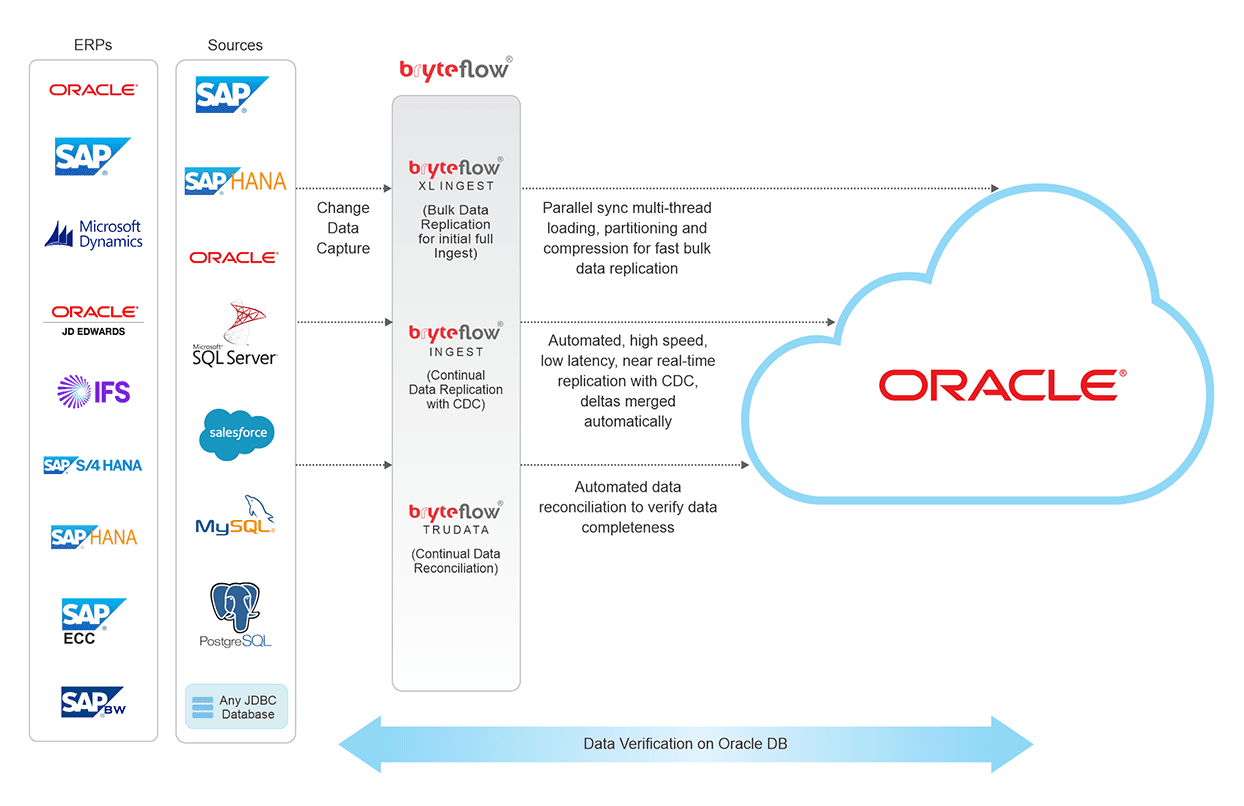Oracle Connections
Move Postgres to Oracle DB without coding
Automate your Postgres to Oracle migration with BryteFlow
BryteFlow can move your high volume data from PostgreSQL to Oracle in real-time and without coding, using log-based Change Data Capture. It transfers petabytes of data in minutes from Postgres to Oracle using parallel, multi-threaded loading and partitioning that is completely configurable. As an enterprise level data replication tool, BryteFlow is ideal for moving heavy datasets and it automates every process, including data extraction, merging, masking, change data capture, schema and table creation and SCD-Type 2.
Postgres CDC Replication with BryteFlow
BryteFlow transfers data from Postgres to Oracle in real-time using CDC
BryteFlow delivers data from Oracle to Postgres in near real-time, with a very high throughput of approx. 1,000,000 rows in 30 seconds. It provides multiple data type conversions out-of-the-box and data is immediately ready for consumption on target – no tedious data prep required. Schema and tables are created automatically on destination so you save hours of effort. With BryteFlow, time to delivery is just 2 weeks, unlike months for most of our competitors.
Postgres CDC – 6 easy Methods to Capture Data Changes
Oracle to Postgres Replication Highlights
- Postgres to Oracle replication is completely no-code, including extraction, table creation, SCD Type2 and merges.
- BryteFlow’s low latency, log based automated CDC does not impact source systems. Postgres to Snowflake : 2 Easy Methods of Migration
- Automated, user-friendly interface creates exact replica or SCD type2 history on PostgreSQL.
- Ingests heavy datasets easily with parallel loading and automated partitioning mechanisms for high speed.
- BryteFlow supports data replication from all versions of PostgreSQL. How BryteFlow Works
- Supports data transfer from Postgres databases on-premise and on Cloud (AWS, Azure and GCP)
- Automated data reconciliation with row counts and columns checksum ensures no data goes missing.
Suggested Reading
BryteFlow for PostgreSQL CDC Replication
SQL Server vs Postgres- A Step-by-Step Migration Journey
Oracle to Postgres Migration (The Whys & Hows)
Data Integration on PostgreSQL
No-Code Postgres to Oracle Migration Tool

Loads huge volumes of data easily from Postgres to Oracle
Parallel multi-thread loading, smart partitioning and compression of data loads petabytes of data for Oracle to Postgres replication rapidly. BryteFlow XL Ingest handles the first full refresh of data followed by BryteFlow Ingest that loads incremental data or deltas continually (or at a specified frequency) using log -based Change Data Capture.
Postgres CDC – 6 Easy Methods to Capture Data Changes
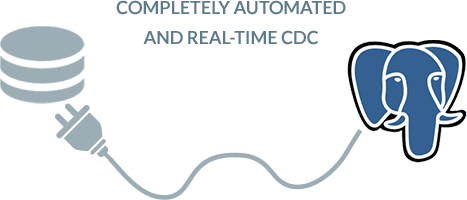
Completely automated, no-code replication tool
Unlike other software that need scripting at some time, with BryteFlow you get complete automation with absolutely no coding. This includes processes like data merges, data extraction, SCD Type2 history, masking, schema and table creation, change data capture and data reconciliation. You get a user-friendly GUI that any business user can use easily.
Oracle to Postgres (The Whys and Hows)
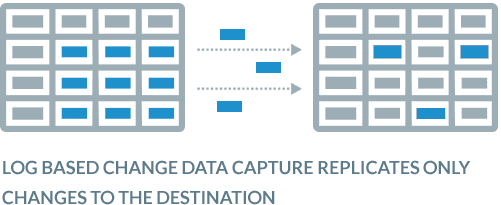
Low impact log-based CDC syncs data with source
BryteFlow uses log-based CDC to update your data and sync it with source. It uses database transaction logs to query the Postgres database at source and copies only the changes into the Oracle target. This is low impact and sparing of source systems. Data in your Oracle database can be updated continually in real-time, or updates can be scheduled as per a frequency of your choice.
Postgres CDC – 6 easy Methods to Capture Data Changes

Your Database Administrator does not need to manage the Postgres to Oracle migration
With BryteFlow you can free up your DBA’s time. Usually a large amount of time is spent in managing the solution. Managing dependencies till process completion, configuring full backups etc. can take up time and increase the TCO of the solution. Also users in most replication scenarios need to have the highest sysadmin privileges. With BryteFlow, it is “set and forget”. Your DBA’s time is not required on a continual basis, hence the TCO is much lower. Further, you do not need sysadmin privileges for the replication user.
Data Integration on PostgreSQL with BryteFlow

Automated data reconciliation to check missing data
BryteFlow ensures your data is complete and nothing goes missing by providing automated data reconciliation using BryteFlow TruData. It does point-in-time data completeness checks for entire datasets including type-2. It compares row counts and columns checksum and provides alerts and notifications for missing data.
SQL Server vs Postgres – A Step-by-Step Migration Journey

Save on GoldenGate licensing costs
With BryteFlow you can avoid licensing costs that might incur if you use Oracle GoldenGate to move your data from Postgres to Oracle. This makes BryteFlow a very economical option.
Oracle CDC (Change Data Capture): 13 things to know

The option to archive data while preserving SCD Type 2 history
BryteFlow enables time-stamped data and the versioning feature allows you to pull out data from any point on the timeline. This versioning feature is critical for performing historical and predictive trend analysis.
Oracle to SQL Server Migration: Reasons, Challenges and Tools

Your data maintains Referential Integrity
BryteFlow provides referential integrity of data. This means that when changes take place in the Postgres database and when they are replicated to the Oracle destination, you can tell exactly what changed at the columnar level, including data, time, values etc.
BryteFlow for Oracle CDC Replication

Data replication 6x faster than Oracle GoldenGate
*BryteFlow is 6x faster than GoldenGate. BryteFlow is also faster than comparable software such as HVR (now acquired by Fivetran) and Qlik Replicate, and loads data at an approx. rate of 1,000,000 rows in 30 seconds. BryteFlow can be deployed faster – in just one day, and time to delivery of data is just 2 weeks. *Results of a client trial.
GoldenGate CDC and a GG Alternative (Cuts Licensing Costs)
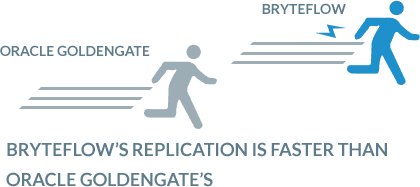
Automated catch-up from network dropout
In case of a power outage or network failure you don’t need to start the Postgres to Oracle replicaton process over again. The replication process automatically resumes from the point it stopped.
Oracle vs Teradata (How to Migrate in 5 Easy Steps)

Automated catch-up from network dropout
If there is a power outage or network failure you don’t need to start the Oracle to Oracle replicaton process again. The replication process automatically resumes from where it stopped.
Postgres to Snowflake : 2 Easy Methods of Migration
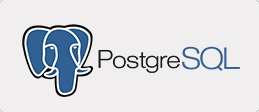
About PostgreSQL
PostgeSQL is an open source, enterprise-grade, relational database management system based on SQL. It extends SQL to cover and scale complex data workloads. Postgres is known for its versatility, extensibility, reliability and data integrity, not to mention its amazing features. It can be run on all prominent operating systems and is ACID-compliant. Postgres innovative add-ons include the useful PostGIS geospatial database extender. Postgres enables users to define their own data types and create custom functions.

About Oracle Database
Oracle DB is also known as Oracle RDBMS (Relational Database Management System) and sometimes just Oracle. Oracle DB allows users to directly access a relational database framework and its data objects through SQL (Structured Query Language). Oracle is highly scalable and is used by global organizations to manage and process data across local and wide area networks. The Oracle database allows communication across networks through its proprietary network component.


